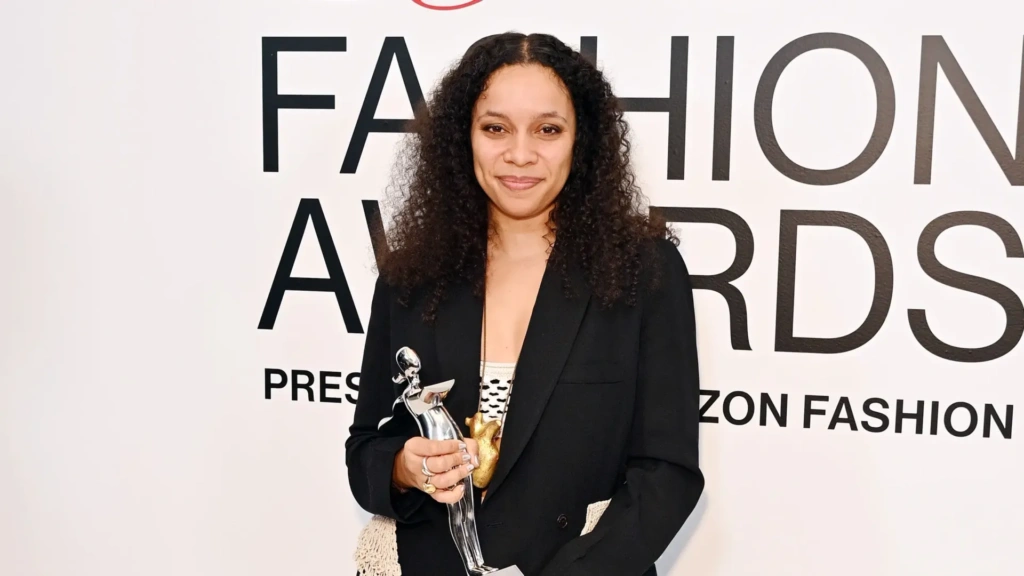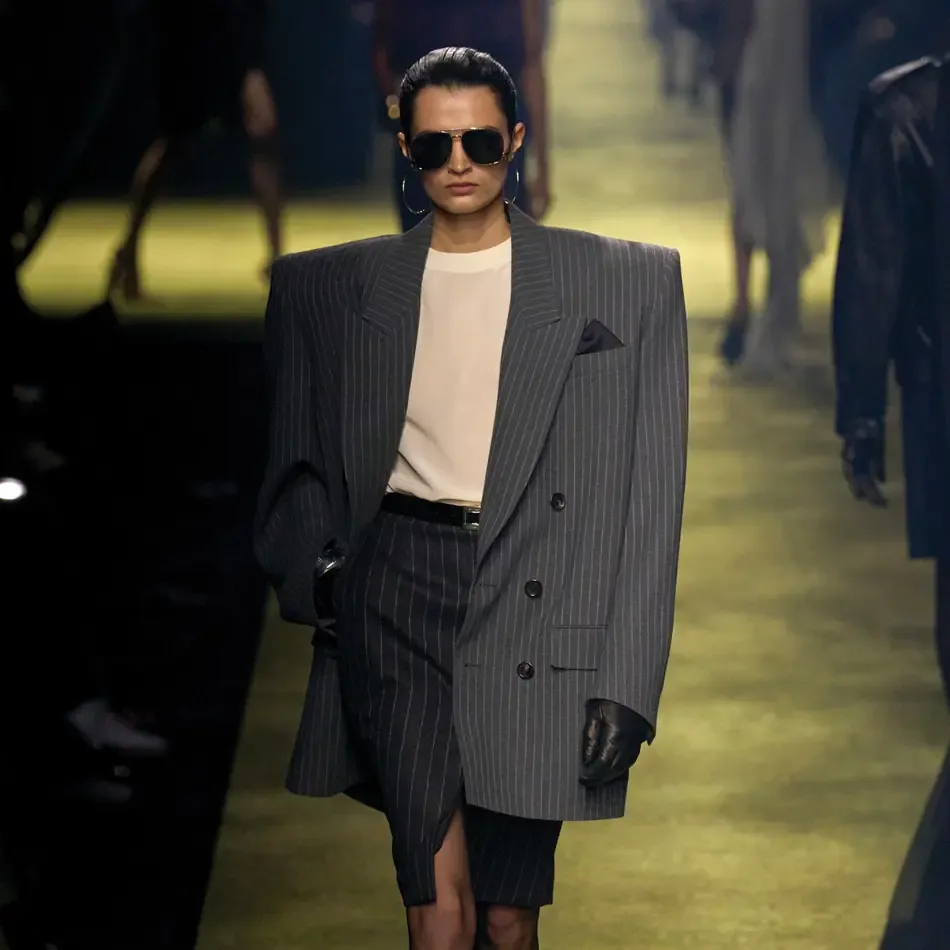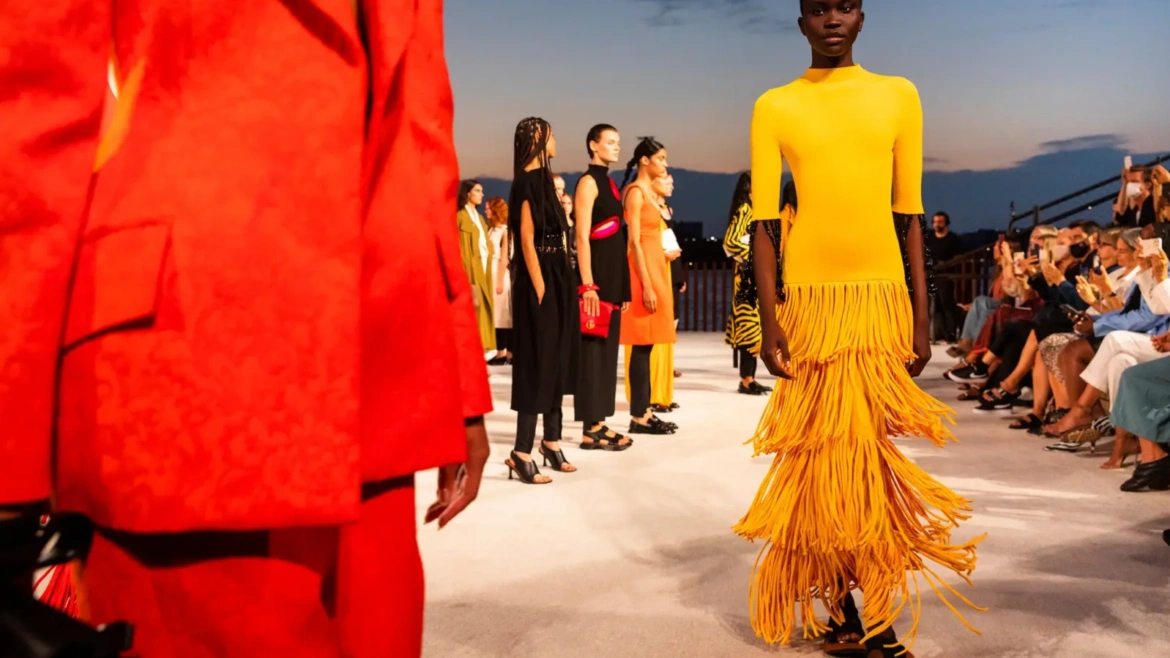The culmination of New York Fashion Week (NYFW) arrived with Thom Browne’s theatrical finale, a spectacle that encapsulated the tension between tradition and subversion in contemporary fashion. A model emerged in a jacket adorned with gold bullion, layered over 130 feet of swathed tweed and voluminous crinolines. The skirt, a labyrinth of tiers and drapes, was so elaborate that it impeded her movement, symbolizing the weight of societal expectations placed on femininity. This moment was not just a showstopper; it was a provocative commentary on the constraints and complexities of womanhood in an era dominated by the resurgence of traditional gender roles, the rise of the “manosphere,” and the cultural influence of platforms like Barstool Sports.
Browne’s collection, like many others this season, grappled with the tropes of femininity—ruffles, lace, corsets, and hobble skirts—but did so with a deliberate irony. In a cultural moment where machismo is ascendant, designers are forced to confront what it means to dress like a woman. Do they embrace hyper-femininity, leaning into the archetypes of the fainting flower, the sex kitten, or the princess in the tower? Or do they reject these tropes entirely, offering something more nuanced and empowering?
The Matriarch as Muse: Diotima’s Vision of Strength and Sensuality
Rachel Scott, the founder and designer of Diotima, offered one compelling answer to this question. Her collection celebrated the matriarch—a woman who juggles household, family, and career with grace and authority. Scott’s designs, a fusion of tailoring and crochet, rejected the flattening of women into one-dimensional stereotypes. Instead, they embraced nuance, complexity, and sensuality. Giant fringed knit lapels erupted from structured suit jackets, layered over openwork tunics and crystal mesh tanks. Traditional suit trousers were replaced with silk bloomers, which Scott described as “the first feminist undergarments.” While bloomers might seem retrograde, Scott reimagined them as a precursor to modern comfort wear, like sweatpants, blending historical significance with contemporary relevance. Her ability to harmonize kitchen-table craft with C-suite sophistication earned her the title of CFDA Designer of the Year in 2024.

Femininity as Fury: Elena Velez’s Survivor Aesthetic
At Elena Velez, femininity was reimagined as fury. Her collection, inspired by shipwrecks and sea creatures, featured cracked cotton shirting, latex-dipped nighties, and dresses adorned with tentacle-like fronds in poisonous green. The models, styled as furious survivors or modern-day Furies, exuded a raw, unapologetic energy. While Velez’s penchant for stunts—such as opening the show with Anna Delvey, the infamous society scammer, or staging mud-wrestling performances—can feel sophomoric, her designs speak for themselves. They are a visceral scream into the void, challenging the viewer to confront the darker, more resilient aspects of femininity.
Reclaiming Identity: Luar’s Celebration of Individuality
Raul Lopez of Luar took a different approach, reclaiming and redefining identity through his collection, titled “El Pato” (Spanish for “duck”). The term, once used as a homophobic slur against Lopez, was transformed into a symbol of pride and defiance. His designs featured puffers filled with feathers, jackets with exaggerated shoulders, and grandiose 1980s silhouettes. While some elements, like bodysuits with hoods that forced the arms into a limp-wrist position, felt heavy-handed, the overall message was clear: personal finery is a form of self-expression and empowerment. Lopez’s collection celebrated individuality, reminding us that femininity—and identity more broadly—is a fungible concept, ripe for reinterpretation.

Sportswear as Subversion: Michael Kors and the Power of the Suit
In a week dominated by explorations of femininity, sportswear emerged as an unexpected site of subversion. Michael Kors, a stalwart of American sportswear, presented a collection of slouchy trouser suits and oversized shirting that rejected the notion of sexiness as synonymous with exposure. “Hands in the pockets, covered up,” Kors remarked. “In a weird way, that’s subversive.” His designs, while rooted in classicism, felt provocative in their refusal to cater to the male gaze. Similarly, Brandon Maxwell elevated separates to the status of power dressing, mixing banker stripes and Prince of Wales checks with polished ease. Christopher John Rogers and Tory Burch also redefined classic sportswear, with Rogers blending burgundy and black suiting with vibrant stripes and Burch introducing “twisted sportswear” featuring cardigans with sliced-open sleeves and leather jackets outfitted with handbag-like pockets.
Carolina Herrera: Tailoring Meets Tradition
Even at Carolina Herrera, where Wes Gordon drew inspiration from the idea of a garden, the collection transcended the trite metaphor of women-as-flowers. While rose-bedecked minidresses and blue-sky lace will undoubtedly appeal to the Palm Beach set, Gordon’s emphasis on tailoring added a modern edge. A gray pinstriped jumpsuit adorned with a gold tulip motif exemplified this balance, offering a fresh take on femininity that was both elegant and empowered. The final opera coat, billowing like a superhero’s cape, underscored the collection’s underlying message of strength and liberation.
Thom Browne: Hope and Heritage
Thom Browne’s collection, set against a backdrop of 2,000 origami white birds symbolizing “hope,” was a masterclass in tailoring and storytelling. Heritage tweeds were reimagined as oversized coats and precise jackets, paired with pleated skirts, narrow trousers, and avian intarsia. Hourglass dresses, sprouting tulle ruffles from the back but structured like cages from the front, served as a metaphor for the constraints of traditional femininity. Yet, the rest of the collection felt like a jailbreak—a celebration of individuality and freedom.
Conclusion: Femininity as Opportunity
This season’s NYFW demonstrated that femininity is not a fixed concept but a dynamic and multifaceted opportunity for expression. From Diotima’s matriarchal elegance to Elena Velez’s furious resilience, from Luar’s reclaimed identity to Michael Kors’s subversive sportswear, designers explored the many ways women can define themselves on their own terms. In an era of cultural polarization, fashion remains a powerful medium for challenging norms and reimagining possibilities. As Thom Browne’s finale so poignantly illustrated, the weight of expectation can be transformed into a source of strength and liberation.
